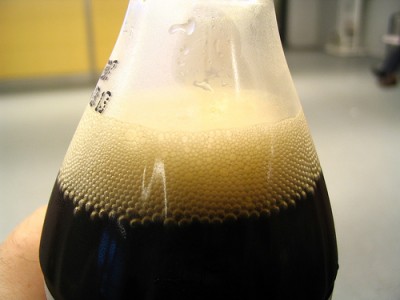Many people believe that tapping on a shaken soda can could prevent it from foaming. However, others do not agree with this. So I will experiment this myth and figure out whether tapping a soda can is useful to avoid a soda explosion.
First of all, let’s see the science in soda can. According to physics law, the amount of dissolved carbon dioxide in the liquid depends on the carbon dioxide’s partial pressure inside the can. Compressed with a large amount of carbon dioxide, a soda can has carbon dioxide partial pressure significantly higher than in normal air. Consequently, the liquid inside the can contains high dissolved carbon dioxide level. Next, when a soda can is opened, the pressure of carbon dioxide inside the can drops. Regarding the Ideal gas law, carbon dioxide gas inside the liquid has more volume and rises to the surface of the solution because its density is lower than liquid. However, some of carbon dioxide is trapped by the liquid on the very top of the can. And this gas creates a million bubbles inside the can.
When a can is shaken, the dissolve carbon dioxide is forced
to become a gas again. So, many bubbles are created on the solution’s surface.
When the can is opened, this bubble layer will block the gas from escaping the
liquid, and form more bubble inside the can. Eventually, there are too much
bubbles, and the soda can starts foaming over.
Many
people believe that tapping on soda can could break the bubble layer down or,
at least, make it thinner. As a result, dissolved carbon dioxide can easily
escape the solution, not causing foaming over. However, some people argue that
tapping soda can does not knock off enough bubbles to avoid foaming over.
Moreover, tapping, perhaps, caused more bubble on the solution because when you
tap, you are adding more energy to the system. Thus, I would like to do an experiment to find a conclusion for this myth.
Here is my methodology. I used two unopened 325ml Coca-Cola
can. Both cans were shaken 10 times within 3 seconds. Next, the first can was
tapped 10 times on the side. Then, both cans were opened at the same time. The
reason for opening both cans at the same time (not open the second can
immediately after being shaken) is to avoid error from time factor. The
duration between shaking and opening could have affected the experiment. And
lastly, the data was collected by investigating whether the Coca-Cola can is
foaming over or not, if so, how much foam coming out.
 |
| Before |
 |
| After |
References:
1. Snopes. Tapping the side of soda can will
prevent its contents from foaming over. Available at: URL: http://www.snopes.com/science/sodacan.asp.
Accessed February 13, 2015.
2. Livescience. Does tapping soda can prevent it
from foaming over. Available at: URL: http://www.livescience.com/34159-tap-soda-can-carbonation.html.
Accessed February 13, 2015
Written by Thana Pongcharoenyong 11
Written by Thana Pongcharoenyong 11


ไม่มีความคิดเห็น:
แสดงความคิดเห็น